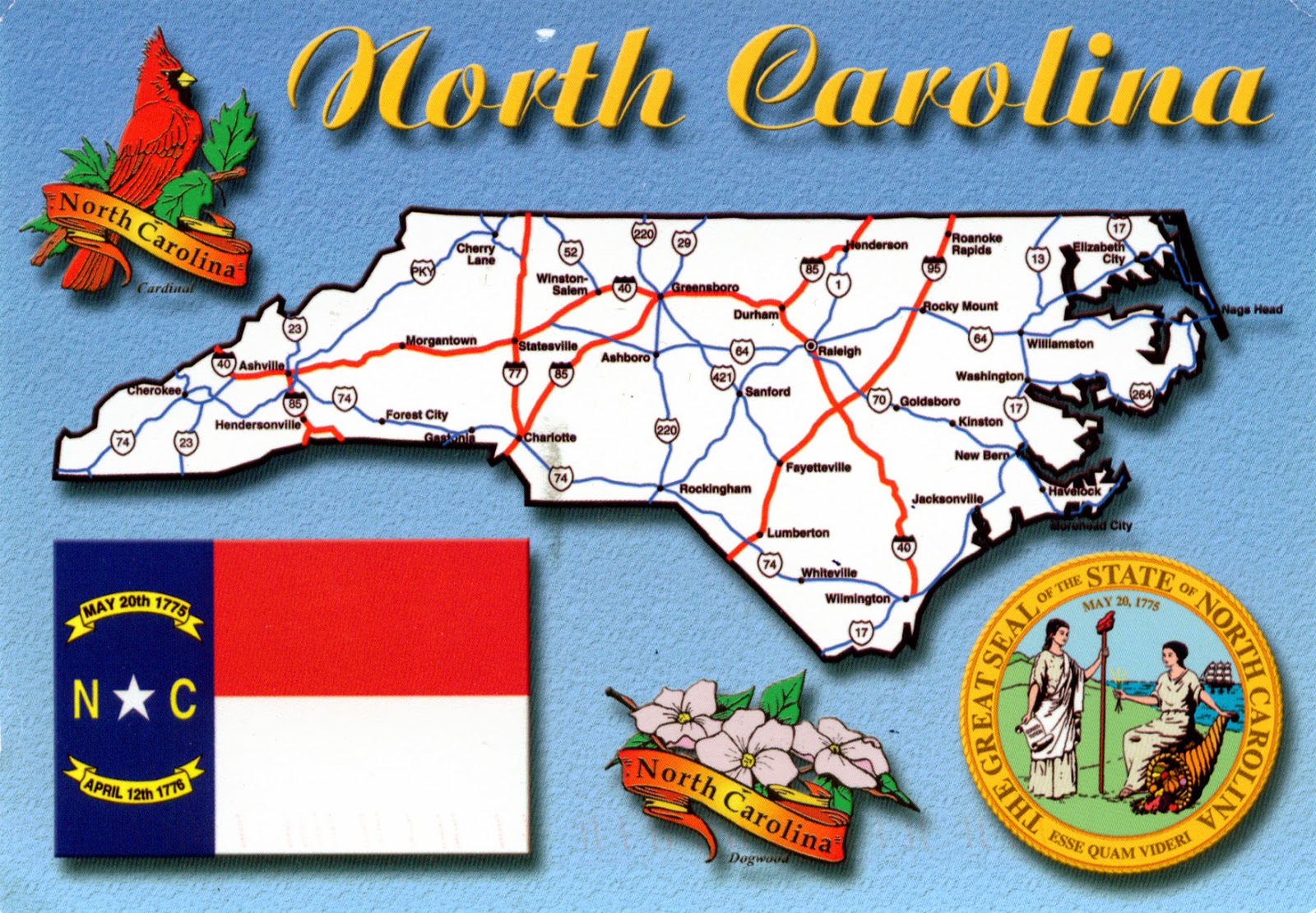September 26, 2014
1247 UNITED STATES (North Carolina) - North Carolina map and flag
Located on the Atlantic coast, between South Carolina, Georgia, Tennessee, and Virginia, and known as the Tar Heel State and the Old North State, North Carolina has a wide range of elevations, from sea level to 2,037m at Mount Mitchell (the highest point in the Eastern US), consisting of three main geographic sections: the Atlantic Coastal Plain, the Piedmont region, and the Appalachian Mountains and foothills. Its capital is Raleigh, founded in 1792 specifically for this purpose, and its largest city is Charlotte. Most of the state falls in the humid subtropical climate zone. In the past five decades, North Carolina's economy has undergone a transition from heavy reliance upon tobacco, textiles, and furniture-making to a more diversified economy with engineering, energy, biotechnology, and finance sectors.
Before the arrival of Europeans, the area known today as North Carolina was inhabited by various peoples, including those of the ancient Mississippian culture, which built large, complex cities and maintained far-flung regional trading networks. Spanish colonial forces were the first Europeans to make a permanent settlement in the area in 1567, a fort which lasted only 18 months. Subsequent the area became one of the English Thirteen Colonies and with the territory of South Carolina was originally known as the Province of Carolina. The northern and southern parts of the original province separated in 1729. Growth was strong in the middle of the 18th century, as the economy attracted Scots-Irish, Quaker, English and German immigrants.
The colonists generally supported the American Revolution, as the number of Loyalists was smaller than in some other colonies.Nevertheless, North Carolina made the smallest per-capita contribution to the war of any state. Instead, in the Civil War 125,000 North Carolinians served in the military, from which 20,000 were killed in battle, the most of any state in the Confederacy. North Carolina was hard hit by the Great Depression, but the New Deal programs of Franklin D. Roosevelt for cotton and tobacco significantly helped the farmers. After WWII, the state's economy grew rapidly, highlighted by the growth of such cities as Charlotte, Raleigh, and Durham.
The flag of the State of North Carolina consist of a blue union, containing in the center thereof a white star with the letters N and C in gilt on the left, respectively on the right. Above of the star is a gilt scroll in semi-circular form, containing in black letters the inscription "May 20th, 1775," and below is a similar scroll containing in black letters the inscription "April 12th, 1776". The fly of the flag consists of two equally proportioned bars, red and white. The Great Seal (standardized in 1871) contains a representation of the figures of Liberty and Plenty, looking toward each other. The background contains a depiction of mountains running from the left to the right. A side view of a three-masted ship is located on the ocean and to the right of Plenty. The dates "May 20, 1775" and "April 12th, 1776" appear up and down. Around the perimeter is writte "Great Seal of the State of North Carolina", and on the bottom the motto of the state, "esse quam videri" (To be, rather than to seem). The state flower is Dogwood (1941), and the state bird Cardinal (1943).
About the stamps
About the first stamp, depicting the president Abraham Lincoln, I wrote here.
The second stamp is one of the two of the limited-edition Hot Rods Forever series, designed by John Mattos, and issued on June 6, 2014. The series celebrates modified 1932 Fords, one of the enduring symbols of Saturday night youth rituals:
• a black car with flame paint job, based on a Deuce roadster made by Vern Tardel
• a red car, McGee/Scritchfield Roadster, built in 1947 by Bob McGee, now part of a permanent exhibit of hot rods in the Petersen Automotive Museum in Los Angeles - it's on the postcard
The last stamp, issued on February 18, 2014, is the thirtieth of the series Literary Arts, about which I wrote here. It honors the novelist, literary critic, scholar and writer Ralph Ellison (1914-1994). With his 1952 novel Invisible Man, a masterpiece of 20th-century fiction, Ellison drew on a wide range of narrative and cultural traditions, shedding vivid light on the African-American experience while setting a new benchmark for all American novelists. The stamp art is an oil-on-panel painting featuring a portrait of Ellison based on a black-and-white photograph by Ellison’s friend Gordon Parks, a renowned staff photographer for Life magazine. The photo appeared on the back of the dust jacket of the first edition of Invisible Man in 1952. The background of the stamp art shows a Harlem street at twilight. The artwork for this stamp was created by Kadir Nelson. Art director Ethel Kessler designed the stamp.
References
North Carolina - Wikipedia
Sender: Denise
Sent from Greenvale (New York / United States), on 15.07.2014
Subscribe to:
Post Comments (Atom)


No comments:
Post a Comment